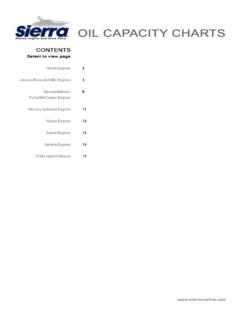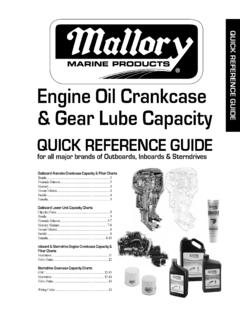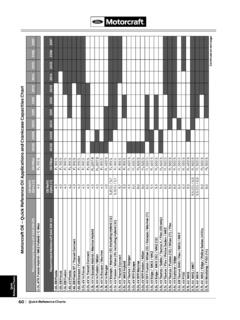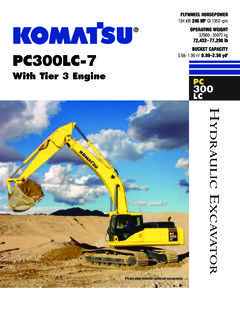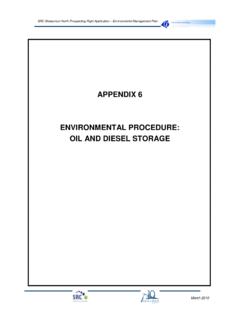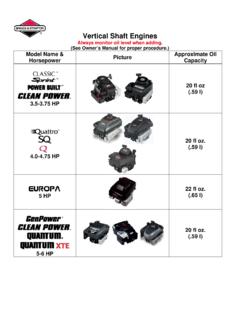Transcription of REFINING U.S. PETROLEUM - AFPM | American Fuel ...
1 REFINING PETROLEUMA SURVEY OF REFINERY USE OF GROWING CRUDE OIL PRODUCTIONM arch 2015A Report byAmerican Fuel & Petrochemical ManufacturersSurvey Conducted byVeris ConsultingCharles LeRoyRefining PETROLEUM A Survey of Refinery Use of Growing Crude Oil ProductionREFINING PETROLEUMA SURVEY OF REFINERY USE OF GROWING CRUDE OIL PRODUCTIONM arch 2015A Report byAmerican Fuel & Petrochemical ManufacturersSurvey Conducted byVeris ConsultingCharles LeRoyRefining PETROLEUM A Survey of Refinery Use of Growing Crude Oil ProductionElectronic AccessThis report is available on AFPM s website in PDF format. It can be found at report was prepared by: American Fuel & Petrochemical Manufacturers1667 K Street, NWSuite 700 Washington, DC 20006202-457-0480 Media questions or comments may be directed to Diana Cronan and technical questions to Joanne Shore PETROLEUM A Survey of Refinery Use of Growing Crude Oil ProductionTable of ContentsSummary ..1 Chapter 1 Introduction.
2 3 Chapter 2 Background ..4 Chapter 3 Survey Approach and Approach ..8 Survey Response ..8 Chapter 4 Results ..10 Respondents Actual and Planned Crude Use ..10 Capability to Run Increasing Crude Production ..12 Changing Crude Unit Yield Patterns ..14 Paths to Using More Light Crude Oil ..16 Investments in REFINING and Infrastructure ..17 Chapter 5 Conclusion ..19 Appendix A. Misunderstanding Refineries Ability to Use Increasing Light Crude Production ..20 Appendix B. AFPM Technical Papers on Processing Light Tight Oil ..23 Appendix C. Survey Form ..25 Appendix D. PETROLEUM Administration for Defense District Map ..31 REFINING PETROLEUM A Survey of Refinery Use of Growing Crude Oil ProductionFiguresFigure 1 Regional Crude Oil 2 Location and Volume of New Production Relative to REFINING Required Significant Infrastructure Changes ..5 Figure 3 Crude Production Growth is Mainly Very Light (>42 API) ..6 Figure 4 Growing Production Reduced Crude Imports.
3 7 Figure 5 Annual Average Historical & Future Tight Oil Changes in Crude Quality ..11 Figure 6 Planned Use of Super Light Crude Oil vs. Capability to Use ..13 Figure 7 Separating Crude Oil into Streams for Further Processing ..15 TablesTable 1 Reported Calendar-Day Distillation Capacity ..9 Table 2 Survey Respondent Refinery Size Distribution ..9 Table 3 Total Refinery Actual and Planned Inputs of Crude Oil by Gravity ..10 Table 4 Share of Crude Quality Inputs (Excluding Condensates) ..10 Table 5 PADD 2 Refinery Actual and Planned Inputs of Crude Oil by Gravity ..11 Table 6 PADD 3 Refinery Actual and Planned Inputs of Crude Oil by Gravity ..12 Table 7 Total Capability to Process Increasing Light Crude Oil Greater than API ..13 Table 8 PADD 2 Capability to Process Increasing Light Crude Oil Greater than API ..14 Table 9 PADD 3 Capability to Process Increasing Light Crude Oil Greater than API ..14 Table 10 Average Crude Distillation Yields.
4 15 Table 11 Light (> 31 API) Crude Volume Increases Allocated to Means of Increase & Ranking by 12 Relative Crude Access Activity by Tight Oil Region and Transportation Mode 2013-2016 ..17 Table 13 2013-2016 Aggregate Investment Ranking to Use More Crude Oil & Associated Crude Capacity Increases ..18 REFINING PETROLEUM A Survey of Refinery Use of Growing Crude Oil Production1 SummaryThe unexpected and welcomed reversal of declining crude production since 2008 has benefitted the nation in many ways. Most of the recent crude oil production growth has come from geologi-cal structures called tight oil formations, which contain very light and sweet (low sulfur) quality crude oils. Refiners run many different quality crude oils, and most refiners have added capability to run heavy sour (high sulfur) quality crude oils. These two facts increasing light sweet production and REFINING heavy sour crude processing capability have created much confusion and misunderstanding about refiners capability to use the increasing volumes of light sweet crude being produced and the economics around the issue (Appendix A).
5 The American Fuel & Petrochemical Manufacturers (AFPM) decided that a simple first step to understanding refiners capability to handle growing supply was to ask its membership about their plans and capabilities for using this new crude. This report highlights the results of the voluntary survey developed by AFPM and administered by a third party. AFPM represents virtually all REFINING and petrochemical manufacturing respondents to this survey represent 61 percent of REFINING capacity. The highest response rates came from the Gulf Coast, East Coast and Midwest regions where much of the new production is being used. The respondent industry subset indicates that from 2014 through 2016, they plan to increase their use of super light crude oil by more than 730,000 barrels per day. Super light crude oil (42 to 50 API gravity1) is the gravity range of most new tight oil production. Furthermore, if logistics access to the new crude oil were not an issue and economics supported increased use of this oil, the respondents have the capability - in place or in progress - to run an additional 800,000 barrels 1 API gravity is a measure of the density of oil.
6 The larger the API gravity, the lighter and less dense the PETROLEUM . Light crude oils are defined for this report at 31 API gravity and higher. Heavy crude oils begin at 24 API gravity and lower. Medium weight crude oils are in between. Planned Use of Super Light Crude Oil vs. Capability to Use2013 2014 2015 20163,5003,0002,5002,0001,5001,00050001, 4111,7232,5892,1492,9172,4563,2541,53186 6798 Thousand Barrels Per DayActual/PlannedCapabilityNote: Capability represents potential volumes that could be run if economics were favorable, and if delivery of the crude oil were not an PETROLEUM A Survey of Refinery Use of Growing Crude Oil Production2in 2016. That amount, over and above the 730,000 barrels per day increase in their current plans, means that the respondent subset alone has a capability to refine million barrels per day more super light crude oil in 2016 than they processed in survey indicates that the respondent industry subset has more than enough processing capability to absorb all new super light oil production that the Energy Information Administration (EIA) is projecting through 2016.
7 EIA s February 2015 outlook2 shows production in the lower 48 states to increase 720,000 barrels per day from 2014 through 2016. This volume contains the tight oil formation production. The federal Gulf of Mexico production is projected to increase another 220,000 barrels per day, but this crude oil is closer to medium sour quality and has properties that make it easier to process than light tight oil. The survey results representing 61 percent of capacity emphasize that refiners are not capacity constrained in the next several years to use the growing super light production from tight oil formations. The survey respondents will achieve their plans to increase use of this new crude production by continuing to reduce imported light and medium quality crude oils and by investing to better utilize this domestic resource. Under more favorable logistics and economic conditions,3 respondents have the physical capability to process substantially higher volumes than reflected in their plans.
8 With nearly 40 percent of the REFINING industry unrepresented in these re-sults, total industry plans for increasing super light crude oil, as well as physical capability to run more light crude oil, represent volumes even larger than the results of this survey. Inadequate delivery infrastructure has delayed refinery access to the new production, but significant changes and expansion in this infrastructure have and will continue to occur. 2 EIA s February 2015 Short-Term Energy The survey did not define explicit economic requirements for respondents to consider when estimating their full capability to process light crude PETROLEUM A Survey of Refinery Use of Growing Crude Oil Production31 IntroductionThe unexpected and welcomed achievement of increasing crude production has benefitted the nation in many ways. These production increases have improved energy security by allowing refiners to back out crude imports from distant, less stable areas of the world.
9 Crude imports from areas outside of North America ( , Canada and Mexico), declined from million barrels per day in 2007 before the large increase in tight oil production to million barrels per day in share of crude oil supply coming from imports outside of North America dropped from 45 percent in 2007 to 23 percent in of the crude oil production increase has come from geological structures called tight oil formations and is very light (high API gravity) and sweet (low sulfur) in quality. Tight oil formations constrain the flow of PETROLEUM , which made them too expensive to produce prior to deployment of advanced drilling and completion processes such as horizontal drilling and hydraulic The recent advances in these production technologies have opened significant domestic PETROLEUM resources to economic development. Refiners process many different quality crude oils, and most refiners have made investments to add heavy sour (high sulfur) quality crude oils. Two apparently disjointed facts increasing light sweet production and high percentage of refineries processing heavy sour oil have created misunderstanding about the capability and economic competitiveness of refiners using increasing volumes of light sweet tight oil (Appendix A).
10 This survey emphasizes refiners capabilities. The question of how much light sweet crude domestic refiners might be able to use with competitive economics in the short term is important information for producers and policymakers. REFINING is a critical part of the evolving energy landscape, and good information about REFINING capabilities is necessary to ensure sound policy decisions. AFPM decided to collect information about refiners capability to handle growing supply by asking its members about their plans and capabilities to use this new crude oil. AFPM members represent virtually all REFINING and petrochemical manufacturing capacity. The survey responses are summarized in this report. The document begins with a brief description of the rapidly changing PETROLEUM environment, and is followed by a chapter describing the survey approach and response rates. The results chapter is divided into the five main areas that were surveyed: actual and planned crude oil use by quality; capability to run increasing crude oil production; changing REFINING crude unit yield patterns; logistics paths used to obtain light crude oil; and investments to increase capability to process light crude oil.

